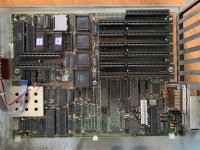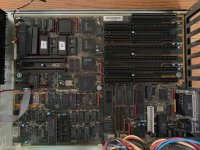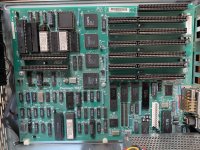sqpat
Experienced Member
I came upon a trio of AST Premium/286es today. They are (as the name implies) 286-based desktop machines with some proprietary technology based around faster memory access and the like. Anyway, I tried two power supplies including one from a working IBM 5150 with a working VGA card from that same machine.
All 3 machines have no video signal, and no beep codes from the speaker when I power them on. (Well, one had no internal speaker). Front panel LEDs were powered. Upon further inspection one machine had no BIOS chips. The fact that it behaves the same as the other two with bios chips makes me think it might be bad BIOS chips (That would suggest no POST/beeps right?)
Another thing, though is that the motherboards don't have memory. I don't yet have the proprietary AST FastRam card. I'm wondering if an owner of this machine knows if you get a silent boot/no error without that card? I tried an ISA memory board and it didn't change boot behavior, and I've seen a forum post that suggested the FastRam card was required - I don't know if that means normal ISA bus memory doesn't work for some reason?
Anyway, I was hoping someone with the machine or manual could chime in if they know anything about boot/post behavior with/without the FastRam card, and if someone might have a working BIOS for this machine. I don't know a lot about replacing BIOS chips and if it can be any old generic 286 bios or not.
All 3 machines have no video signal, and no beep codes from the speaker when I power them on. (Well, one had no internal speaker). Front panel LEDs were powered. Upon further inspection one machine had no BIOS chips. The fact that it behaves the same as the other two with bios chips makes me think it might be bad BIOS chips (That would suggest no POST/beeps right?)
Another thing, though is that the motherboards don't have memory. I don't yet have the proprietary AST FastRam card. I'm wondering if an owner of this machine knows if you get a silent boot/no error without that card? I tried an ISA memory board and it didn't change boot behavior, and I've seen a forum post that suggested the FastRam card was required - I don't know if that means normal ISA bus memory doesn't work for some reason?
Anyway, I was hoping someone with the machine or manual could chime in if they know anything about boot/post behavior with/without the FastRam card, and if someone might have a working BIOS for this machine. I don't know a lot about replacing BIOS chips and if it can be any old generic 286 bios or not.




